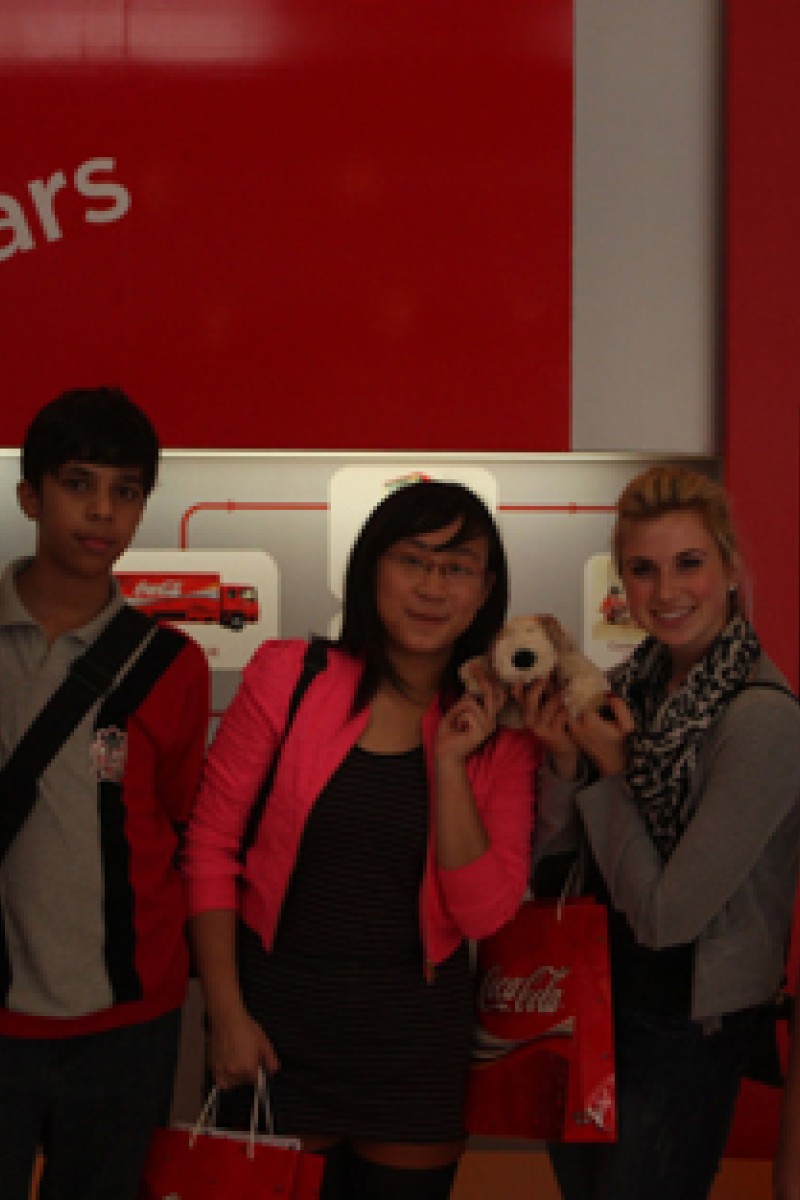
Our junior reporters go behind the scenes at the soft drink factory in Sha Tin, where a newly renovated gallery tells the story of the brand's past, future - and weird inventions
 Junior reporters with Dennis on their visit. (Left to right) Ricardo Wong, Dhruv Singh, Janet Tam, Samantha Sugarman, Joseph Li
Junior reporters with Dennis on their visit. (Left to right) Ricardo Wong, Dhruv Singh, Janet Tam, Samantha Sugarman, Joseph LiSamantha Sugarman
From Space Coke to Ice Coke, all of the company's memorable inventions were on display on the visitors' floors.
For hot summer months, Coca-Cola has invented a machine that produces bottled drinks with refreshing ice inside. Kept in a zero-degree Celsius vending machine, these iconic drinks come with simple instructions: twist, sip, enjoy. But in Hong Kong, there are only a few of these summer dream machines for sweltering citizens.
Aside from an impressive display of Coca-Cola products, the plant had great viewing platforms from which we were able to see several production lines. With 20 brands and more than 90 beverage flavours, this plant produces more than 60 million drinks a year.
Dhruv Singh
Coca-Cola invested US$250,000 just to develop 200 cans of Coke for astronauts. The crew on the space shuttle Challenger could enjoy Coke while they were in orbit - all for the price of US$1,250 for each little "space can".
You may have seen Coke Zero in many supermarkets and convenience stores. But it retains the classic taste of Coke even though the company boasts it contains no artificial flavourings and no sugar. A special type of chemical is added or a certain part of the "secret Coke recipe" is left out. Coke Zero was launched for men, who wouldn't drink Diet Coke because the word "diet" has a stronger association with women.
Janet Tam
This was my second visit to the Coke plant. The previous tour focused only on raw materials and the beverage manufacturing process, but this time the visit was more varied.
The recently renovated gallery provided more interactive demonstrations than last time, such as machines that detected the body's hydration level and a plastic recycling machine. The brand new viewing gallery uses "Live Positively" as its theme. It is divided into seven core areas that exhibited various memorable collections. This second visit gave me a refreshing impression of the Coke plant.
Ricardo Wong
I was most impressed by Coca-Cola's emphasis on environmental friendliness. Coca-Cola is one of the most popular beverage brands in the world, operating 17 production lines for soft drinks, tea, fruit drinks and water. Yet the company is determined to uphold environmentally friendly values: reduce, recycle and reuse.
The company encourages people to adopt a greener lifestyle. For example, it reduces the production of glass bottles by encouraging customers to return used bottles to some shops; the bottles are then reused more than 20 times.
The plant also recycles water in its operation through waste-water treatment. Its commitment to sustainability is admirable. We can do the same in our daily lives if we are truly determined to help the environment. Next time you finish your bottle of Coca-Cola, remember - reduce, recycle and reuse!
Joseph Lai
The Coca-Cola plant tour was an amazing experience because it took us behind the scenes of one of the most loved drinks in Hong Kong. This bottling plant is the tallest in the world at 147 metres high.
On the seventh floor, we learned about the hydration machine and Coca-Cola's commitment to helping the environment. I was invited to test out the hydration machine, which indicated the water level in my body. As it turned out, I was slightly dehydrated at 51.2 per cent; the normal level is 60 per cent.
Further up, on the 17th floor, we visited a museum. There was a historical jukebox that was worth HK$80,000. All in all, the tour was an amazing opportunity to learn more about the soft drink that we take for granted every day.